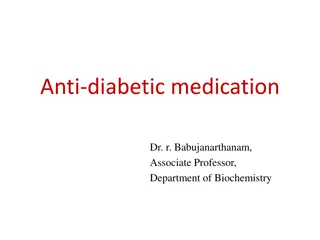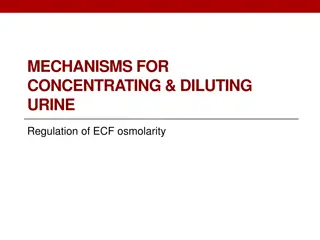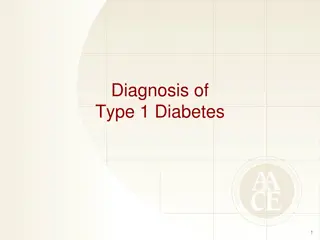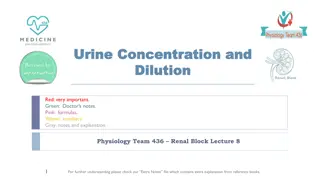Water Deprivation Test for Diabetes Insipidus Diagnosis
The Water Deprivation Test is a diagnostic tool used to identify diabetes insipidus in patients presenting with symptoms such as polyuria and polydipsia. By assessing serum and urine osmolality levels, this test helps differentiate various forms of the condition, guiding further management. Precautions, interpretation criteria, and potential side effects associated with the test are crucial for the safe and accurate evaluation of patients suspected of having diabetes insipidus.
Download Presentation

Please find below an Image/Link to download the presentation.
The content on the website is provided AS IS for your information and personal use only. It may not be sold, licensed, or shared on other websites without obtaining consent from the author.If you encounter any issues during the download, it is possible that the publisher has removed the file from their server.
You are allowed to download the files provided on this website for personal or commercial use, subject to the condition that they are used lawfully. All files are the property of their respective owners.
The content on the website is provided AS IS for your information and personal use only. It may not be sold, licensed, or shared on other websites without obtaining consent from the author.
E N D
Presentation Transcript
Rationale -This test is to establish the diagnosis of diabetes insipidus in a patient with polyuria, polydipsia, and possibly hypernatremia. - With dehydration and increased plasma osmolality, vasopressin (VP) is released from the hypothalamus/posterior pituitary gland. - Under the influence of VP, water is reabsorbed from the collecting duct lumen into the hyper osmotic renal medulla along the osmotic gradient. -This results in the production of concentrated urine.
Interpretation - If: *Serum osmolality is 275-295 mosmol/Kg *Urine osmolality > 600 mosmol/Kg *Urine/serum osmolality ratio >2 *The patient will be considered as having normal posterior pituitary reserve and further testing is not indicated.
Precautions - Before commencing the test hypothyroidism, cortisol deficiency and osmotic diuresis must be excluded. - dDAVP (1-desamino=8-D-arginine vasopressin) should not be used in patients with vascular disease especially coronary atherosclerosis and renal failure. - It is important to monitor vital signs during the dehydration procedure.
Side effects -dDAVP may produce water intoxication only if there has been an increase in urine osmolality. - Because of this, patients must not be allowed to drink freely after completion of the test if they have responded to the drug. - The early sign of water intoxication are drowsiness, listlessness and headache.
- If weight loss exceeds 2Kg (or 5% in children) or the clinical condition deteriorates, the test must be stopped. - If the given protocol is followed, adverse effects could be minimised. - - - Water deprivation test is not indicated * if serum sodium is > 145 mmol/L. *Check the serum osmolality.
-If the serum osmolality is > 300 mosm/Kg water in a patient suspected of having diabetes insipidus, or in very small children, testing can be done without subjecting the patient to a period of dehydration. - Check basal serum and urine . osmolality - Give dDAVP (see below for dose) - Test serum and urine osmolality 2 hours later.
Procedure -The laboratory must be given notice in advance of commencement of test/specimen collection . - Ensure availability of a ward environment in which the patient can be observed and in which the patient does not have access to any water, including hand washing basins, toilets etc. - If mild polyuria exists, the subject should be fasted from 2200 hours (10.00 pm) the night before the test. - If moderate to severe polyuria exists, the subject should be fasted from 0700 hours on the day of the test. - In children the test should be carried out in the day time under supervision.
- Prior to fasting (before 0700 hours- 7.00 am) , weigh patient, take random urine( 1-2 ml) for osmolality (do not use any preservative) and collect blood (2 ml) for osmolality and serum sodium. - Collect urine hourly from 0800 hours (8.00 am) on day of the test into a clean dry container and send immediately to the laboratory for measured osmolality. -Weigh patient hourly from 0800 hours until completion of the test. - Continue until urine osmolality shows < 30 mOsmol/Kg water difference between three successive collections.
- Draw a sample of blood (1ml) for measured osmolality and sodium when the plateau is reached. -The laboratory will inform this to the ward. - After blood has been collected, inject 5 units of aqueous vasopressin subcutaneously or administer intranasal desmopressin acetate in the following doses: *Adults 0.4 ml (40 micrograms) *Children 0.2 ml (20 micrograms) *Infants 0.1 ml (10 micrograms) - One hour later collect urine for measured osmolality and blood sample for measured osmolality and sodium. - If there is no definite change in urine osmolality repeat measurement of osmolality in urine one hour later
Urine Urine osmolality osmolality ( (mosmol mosmol/ /Kg water) water) before dDAVP dDAVP Increase in Increase in urine urine osmolality osmolality after after dDAVP dDAVP Serum Serum osmolality osmolality ( (mosm mosm ol ol/ / Kg water) water) before before dDAVP dDAVP Kg before Kg 800 ( > 400 usually) < 9% < 300 Normal Serum Na is normal Diabetes Insipidus <800( < than that of serum) > 50% to reach 800 May be >300 -Central hypothala mic < 10% -Nephrogenic Partial Central usually < 300 Urine osmol> Plasma Increase to < 800 ( peak of 300- 600) Partial nephrogenic 300< urine < 800 No response
- In complete nephrogenic diabetes insipidus, VP levels exceed 3 ng/L when plateau osmolality is reached, -whereas in complete central diabetes insipidus, VP levels do not exceed 1.5 ng/l. - Psychogenic polydipsia can be excluded when: 1. Serum Na > 145 mmol/L or serum osmolslity > 300 mosmol/Kg water 2. Urine/ plasma osmolality < 1.5
Sample Collection Osmolality: - Collect fresh urine (1 ml) and serum (1 ml) samples into a plain bottle without a preservative. - Transport to the laboratory as soon as they are collected. - Laboratory should analyze them promptly
Antidiuretic hormone (ADH) or (VP) - Blood specimens for ADH are collected into chilled tubes containing EDTA as an anticoagulant. - Specimens should be transported to the laboratory on ice and centrifuged at 40C within 30 min of collection. - Plasma is then removed and stored at frozen at -20 C until analysis is performed. - Significant deterioration occurs with prolonged storage.
Reference ranges Serum: - neonate may be as low as 266 mOsmol/kg H2O - child and adult 275-295 mOsmol/kg H2O - > 60 yr 280-301 mOsmol/kg H2O























